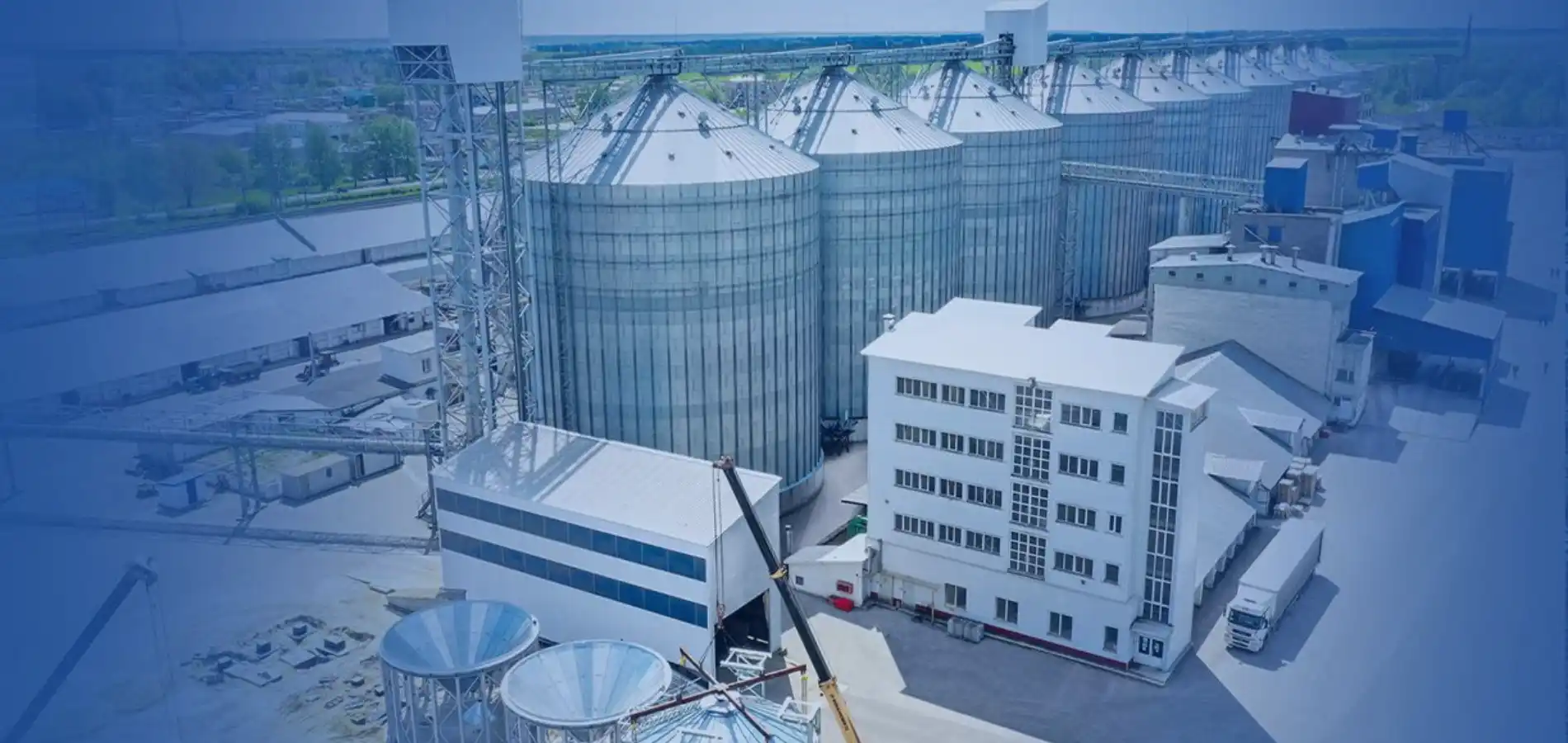
Feed Dryer Machine
Feed dryer machine can dry the puffed feed, evaporating the excess moisture in the puffed feed through heat exchange, allowing it to be stored safely and stored for a long time. This equipment plays a key role in feed processing, connecting the puffing machine with the subsequent packaging process, directly affecting the quality and production efficiency of the feed.
RICHI provides a series of mesh feed dryers of different sizes and outputs, which fully consider the application of equipment and the actual needs of customers.If you have questions about dryers, such as price, model, etc., please click the button below and feel free to ask us.
Main power: 5.5-37KW
Volume capacity: 6-150m³
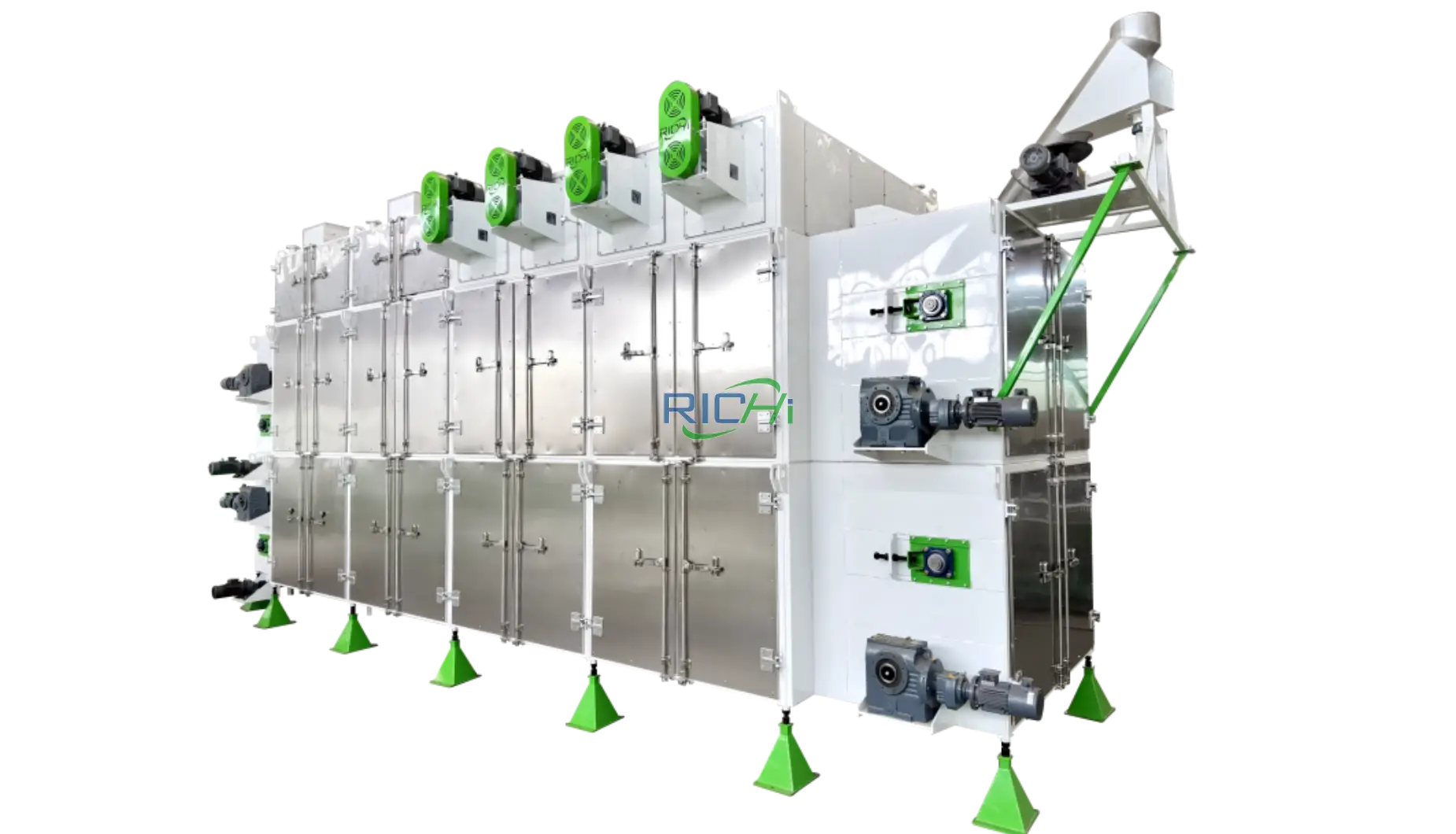
Working principle of feed dryer machine
Feed dryer machine, also known as belt dryer machine, mainly uses mesh conveyor belts to carry materials and achieve uniform drying through hot air circulation. Here is its detailed working principle:
Material conveyance
- Materials waiting to be dried, like expanded feed, biomass pellets, and grain products, are evenly spread on the conveying mesh belts by pipes. Each motor is paired with one layer of the mesh belt, and the motor is equipped with a frequency converter to adjust the mesh belt speed.
Hot – air circulation
- The high – temperature hot air generated by the heating system is conveyed into the inside of the dryer through pipelines. The hot air forms a circulating flow inside the dryer and conducts sufficient heat exchange with the materials on the conveying mesh belt.
Evaporation of moisture
- .Under the effect of the hot air, the moisture in the materials is evaporated and flows upwards along with the hot air. Meanwhile, there’s a fan at the upper end of the oven. The humid and hot air is discharged by a fan to maintain a dry environment inside the dryer.
Water evaporation
- Under the action of hot air, the moisture in the material and flows upward with the hot air. At the same time, there is a bellows at the upper end of the oven, which discharges humid and hot air through the fan to maintain the drying environment inside the dryer.
Discharge
- When the material passes through the drying area of the dryer machine, its moisture content has reached the requirements. Each layer of mesh belt runs to the tail, and the material enters the lower mesh belt through the hopper, and then proceeds in turn, and is finally discharged from the discharge port to complete the entire drying process.
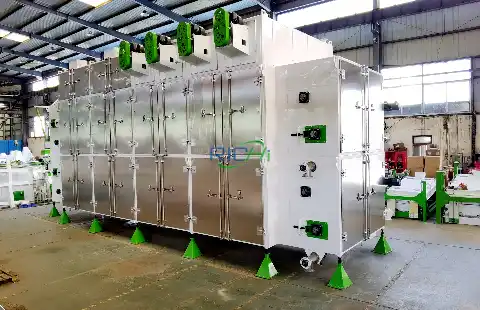
Material conveyance
Hot – air circulation
Evaporation of moisture
Water evaporation
Discharge

About feed dryer machine
A feed dryer is a mechanical device that rapidly and evenly dries expanded feed, which has been extruded under high temperature and high pressure, through hot – air circulation. Mesh feed dryer is a mechanical device that quickly and evenly drys extruded feed extruded through high temperature and high pressure through hot air circulation. Its purpose is to reduce the moisture content of the originally high – moisture feed pellets to around 10% after drying. This helps prevent mold growth, ensures product quality, and extends the storage time.
This feed drying machine is widely used in fields such as extruded feed, pet food and cereal products. It can accurately control moisture to prevent mold, protect the quality of feed pellets, and facilitate storage.
The video below shows the test run of the RICHI feed dryer machine with material in the Australian 1 T/H floating fish feed plant project.

Aquatic feed processing
Feed dryers are widely used for drying various aquatic feeds, such as floating and sinking fish feeds, shrimp feeds, etc. Aquatic feeds generally require the pellets to maintain stability in water for a certain period. The dryer ensures that the feed pellets won’t deform or crack during the drying process by controlling the temperature and humidity. Meanwhile, it achieves the ideal moisture content and extends the shelf life.
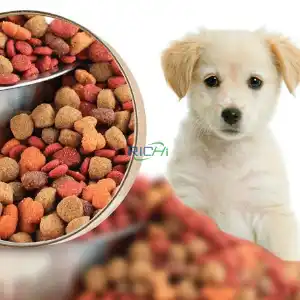
Pet food production
In the pet food industry, dryers are used for drying extruded pet food. The drying process needs to retain the nutrients and taste of the feed. By precisely controlling the drying parameters, we can ensure product quality and meet the high requirements of the pet food industry for taste and nutrition.
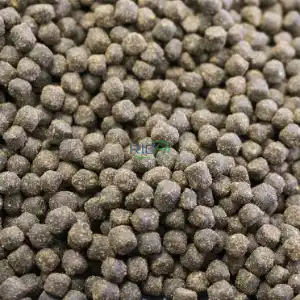
Special feed processing
For special breeding feeds like sea cucumber feed, dryers are customized in design, such as adjusting the number of belt layers and the heating method. This allows them to meet the drying needs of high – sugar and high – moisture feeds, reduce the mold – growth rate, and improve feed utilization.

Cereal products field
After the cereal is puffed, the moisture content decreases, the feed’s sensitivity to humidity is weakened, and it has great advantages in storage, transportation and other links. The extruded feed dryer can further reduce the moisture content of the cereal products and improve its preservation performance. At the same time, it can also reduce the risk of bacterial contamination of cereal products and ensure their cleanliness and health.
Key Components and Structure of a Feed Dryer Machine
After understanding the working principle, you also need to understand the main parts of the feed dryer machine and comprehensively consider the performance of the equipment to buy a durable and high-yield feed drying machine.
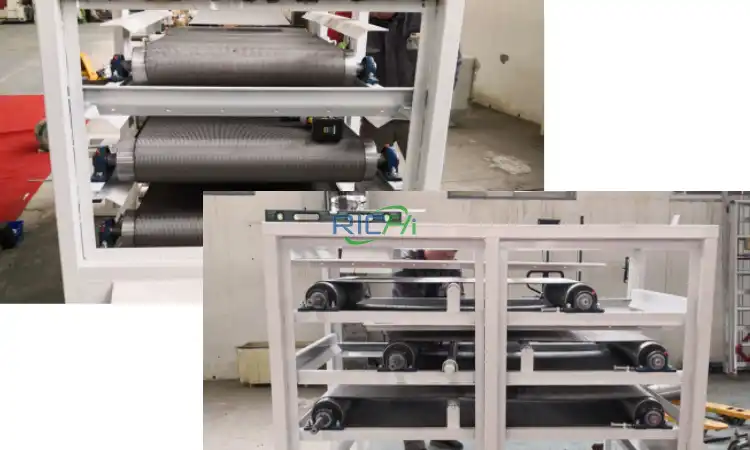
- Feeding device: There is a pipe above the machine, and the materials are evenly laid on the conveying mesh belt.
- Conveying mesh belt: A single – layer or multi – layer (usually 3 – 5 layers) stainless steel mesh belt is used to support and convey the materials.
- Hot Air System:It typically consists of a hot air furnace, a burner, and a heat exchanger, etc., which is used to generate high-temperature hot air and provide a heat source.
- Drying box body:It has an insulated and sealed structure to reduce heat loss.
- Transmission device:It is driven by a motor. The motor drives gears to pull chains, which in turn move the crossbars. The crossbars then drive the mesh belts to operate. The speed can be adjusted according to the state of the materials.
- Humidity exhaust system:The moisture exhaust fan is used to discharge the moisture generated during the drying process, maintaining a dry environment inside the dryer.
- Discharge Device:It is used to discharge the dried materials from the dryer.
Main types of feed dryer machine
There are mainly two types of RICHI feed dryer machines. One is the ordinary dryer machine belt, which is suitable for single-screw extrusion line .The other is the mesh -belt circulating dryer, generally applicable to double – screw extrusion lines. Each of them has its own advantages.
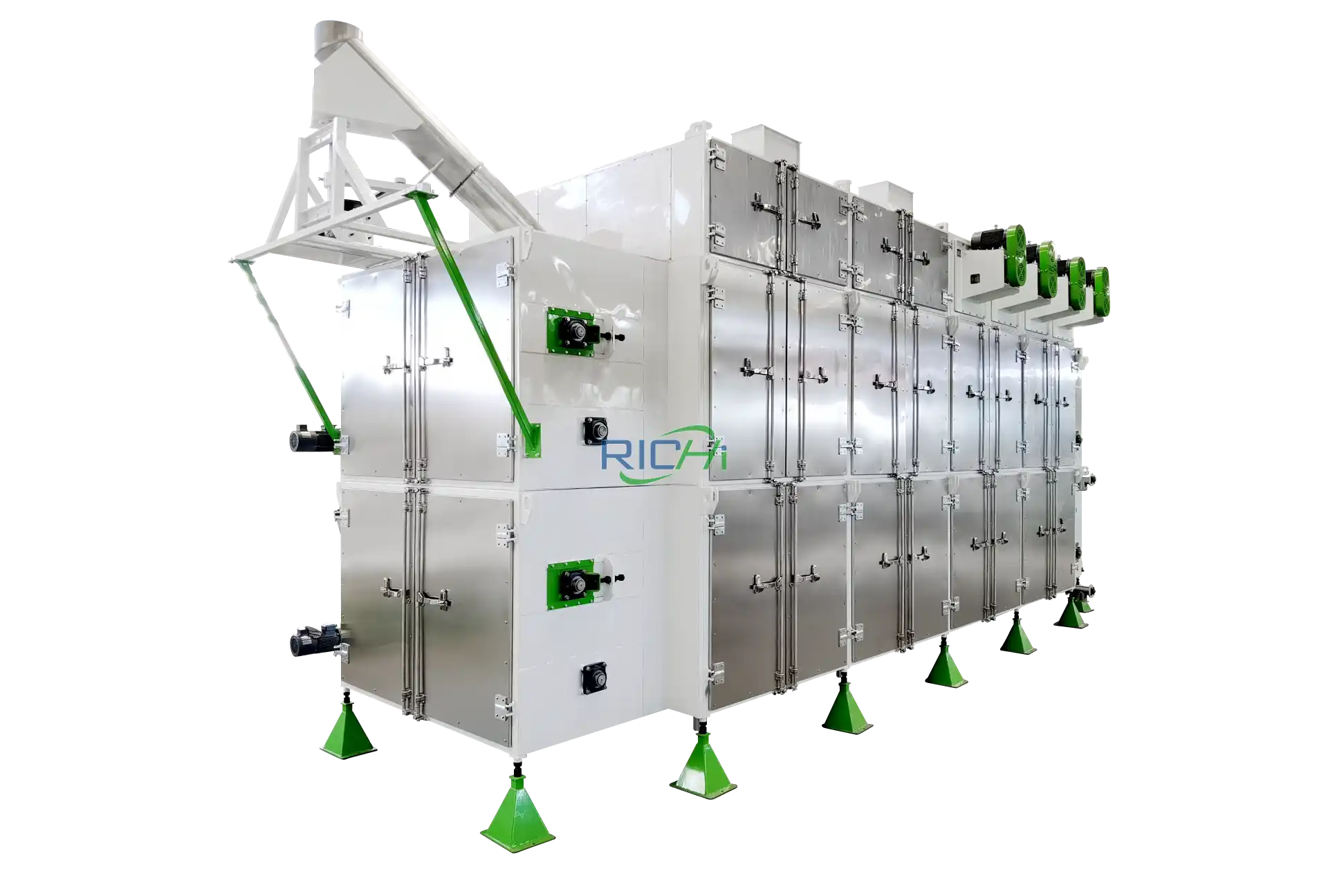
Fish dryer machine
- The equipment structure is clear, which makes it easier for workers to start operating faster. There is no complex circulation air circuit design, the number of parts is small, the cost is relatively low, and the maintenance is convenient.
- It can flexibly handle various materials, especially those with good air permeability like pellet, flaky, and strip – shaped ones. It has a high tolerance for different material forms.
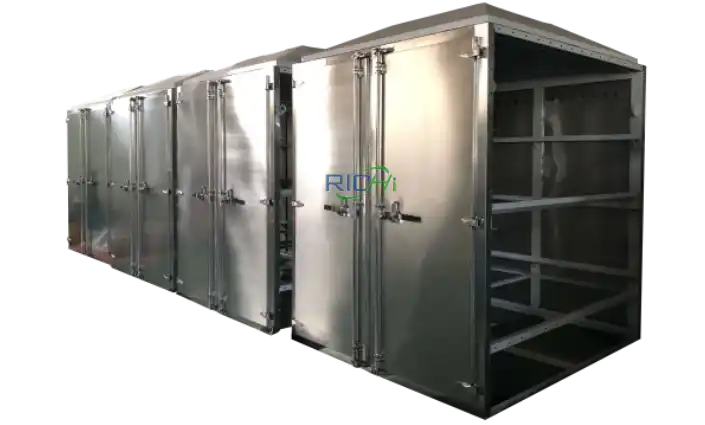
pet dryer machine
- All the materials of this belt dryer machine are made of stainless steel, and the internal mesh belt is Teflon, which is more high temperature resistant, better breathable, making it more conducive for hot air to enter.
- Heat source provision: There’s a heat exchanger above the machine, and there are steam plates. Heat exchange takes place between the steam and the materials on the mesh belt to dry the materials.
- With circulation function inside: The fan above the machine extracts the humid air inside the oven and recommits to the heat exchanger for secondary heating. This way, it continuously dries the materials, enhances the utilization of the heat source, and saves fuel.
Both of these two types of dryers are widely used in various production lines for aquatic feed and pet feed. They can effectively reduce the moisture content in extruded feed to an appropriate standard. In practical applications, RICHI can provide suitable models and configurations of feed dryers according to the characteristics of customers’ materials and production requirements, so as to achieve the best drying effect.

Cases of feed dryer machine
RICHI machinery’s dryer customers are all over the world. From consultation to late delivery of products, we follow up services throughout the process. We flexibly equip related parts according to different products of customers to achieve efficient output of feed products.
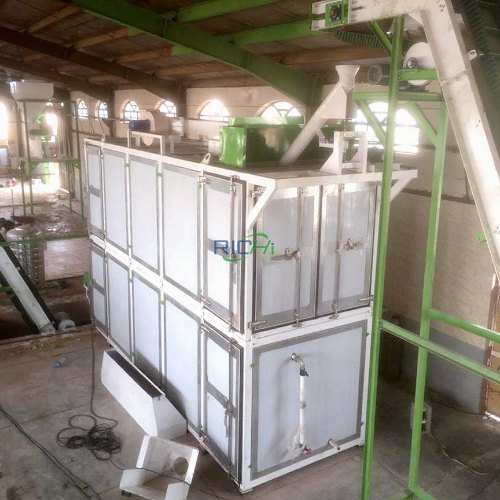
2024.03
Malaysia 1.5-2T/H Seawater Fish Feed Drying machine Project
- Country: Malaysia
- Project Background: The client is a local aquatic feed company that has long cooperated with the government fishery. It mainly supplies marine fish farms such as tuna and tilapia, and has very strict product quality control.
- Drying requirements: Due to the high humidity and high temperature in the local area, the client requires that the moisture content of the dried puffed feed be stably controlled at 10%-12%, and it must meet the storage and transportation standards for export to ASEAN countries.
- Solution: RICHI customized a five-layer fish feed dryer machine for it, equipped with an intelligent temperature control and humidity adjustment system. The mesh belt is made of 304 food-grade stainless steel and anti-corrosion treatment to ensure that the equipment still has high stability in long-term operation on the tropical seashore.
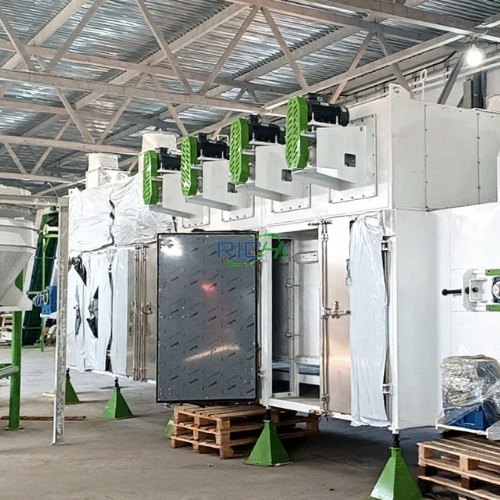
2023.11
Philippines 1-1.5T/H Shrimp Feed Drying equipment Project
- Country: Philippines
- Project Background: The client focuses on breeding white shrimp, with a feed particle size of 0.5-2mm, and has extremely high requirements for stability in water. Previously, the use of traditional drying equipment had problems such as uneven drying and high powdering rate.
- Drying requirements: The target moisture content is controlled at 7%-9%, ensuring stability in water for more than 4 hours; at the same time, the equipment is expected to be easy to maintain and highly automated.
- Solution: RICHI provides customized solutions, using a compact four-layer fish feed drying machine, supporting full PLC control, and precise and adjustable drying time; customer feedback shows that the particle qualification rate has increased to more than 98%, the equipment runs stably, and daily maintenance is simple.
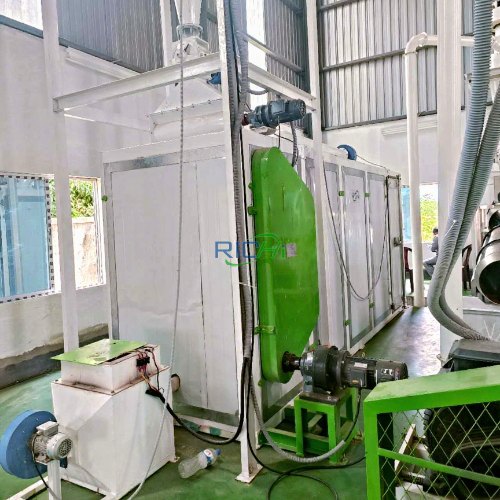
2024.05
Italy 2T/H Premium Pet Food Drying machine Project
- Country: Italy
- Project background: The customer is an Italian high-end pet food manufacturer, and its products are exported to Germany, France and other countries. It has extremely high standards for the appearance, taste and nutritional retention of cat and dog food particles.
- Drying requirements: Ensure that the surface of pet food is flat, the particles are intact, and the moisture content is controlled at 6%-8%; low-temperature drying is required to prevent nutrient loss.
- Solution: RICHI chooses four-layer intelligent drying equipment, integrated with intelligent variable frequency fan system, to achieve low-temperature circulation drying throughout the process; customers report that the product appearance is better, the moisture fluctuation is about 0.5%, and it meets the production standards of high-end pet food.
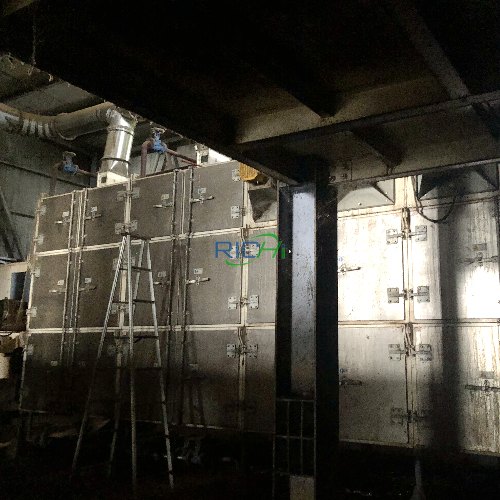
2023.08
Egypt 2T/H Tilapia and Catfish Feed Drying machine Project
- Country: Egypt
- Project Background: The customer has an aquatic feed factory, which mainly supplies tilapia and African catfish farms in the Nile River Basin.
- Drying requirements: It is required to reduce the moisture content of high-humidity pellet feed from 25% to 10%-12%, and ensure that the drying process is dust-proof, anti-blocking, and high-temperature damage to raw materials.
- Solution: RICHI supplies five-layer circulating drying equipment, using high-temperature hot air furnace + spiral duct cloth system, combined with a sealed drying box, to improve drying efficiency while reducing energy consumption. Customers are particularly satisfied with the thermal control system.
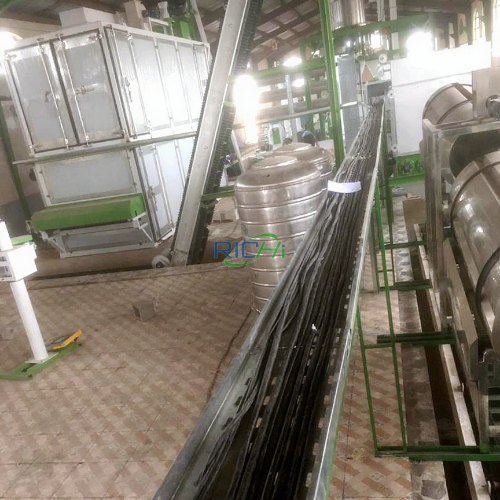
2025.02
Chile 1T/H Salmon Aqua feed Drying mill Project
- Country: Chile
- Project Background: The client is one of the salmon feed exporters in Chile. The raw material is high-fat extruded feed, and it attaches great importance to the color, nutrition and smell retention after drying.
- Drying requirements: Control the moisture content at 8%-10% to prevent oil oxidation, ensure the integrity of the particle appearance, and meet the standards for export to Japan and North America.
- Solution: Use RICHI four-layer automatic drying equipment, equipped with precise temperature and humidity sensing system, oil isolation plate structure and automatic alarm system; customer feedback shows that the finished product consistency is stronger, and the finished product inspection pass rate has increased from the original 91% to more than 96%.

Advantages of RICHI Feed Dryer Machine

- The hot air circulation system is adopted, which can save energy by more than 30% compared with the traditional non-circulating dryer. The hot air is recycled many times in the system until the humidity reaches the set value, and then it is partially dehumidified by the dehumidification fan, and dry cold air is introduced to effectively reduce energy consumption.
- The hot air temperature is dynamically adjusted through the automatic control system, and the highest and lowest temperatures can be set. The system automatically adjusts the steam flow according to the feedback from the temperature sensor to ensure the stability of the drying temperature, prevent overheating or insufficient drying, and ensure the quality of feed.
- The equipment adopts a multi-layer mesh belt structure design to effectively increase the drying area. The material is transported in layers between different layers of mesh belts to avoid accumulation and agglomeration, making the drying more uniform.
- The imported PET woven mesh belt has high ventilation efficiency, strong temperature resistance, stable operation, and effectively improves the drying efficiency by more than 25%.
- The drying time can be freely adjusted according to the shape and thickness of the material to avoid the “wet core” phenomenon of the material and improve the product qualification rate.
- Each temperature zone of the feed dryer machine is equipped with an independent circulation fan, heating device and fresh air system. The temperature is gradually raised from low temperature to 100℃ and then slowly lowered. The discharge temperature is set at a low level to effectively prevent the nutrients from being damaged and ensure the integrity of the nutrition and appearance of the pellet feed.
- The upper and lower convection + left and right cross hot air circulation mode is adopted, and the material is evenly heated on all four sides, the moisture deviation rate is <2%, and the drying consistency is strong.
- Equipped with a large flow forced ventilation device to improve the permeability of hot air; the operating parameters (such as temperature, humidity, and air volume) can be independently controlled to achieve the best drying effect.
- It is particularly suitable for drying materials with high moisture content such as aquatic puffed feed and pet feed. After drying, the moisture content can be controlled in the range of 2%-10%, which is conducive to subsequent oil injection, cooling, storage and other operations.
Frequently asked questions

How to choose a suitable feed dryer?
Select according to the material characteristics: the density, moisture content of different materials varies, and the appropriate drying temperature and mesh belt speed need to be selected.
Consider capacity requirements: Choose the appropriate equipment model and drying layer number according to the production scale.
Pay attention to the type of heat source: Choose electric heating, steam heating or gas heating according to local energy conditions and costs.
Attach importance to after-sales service: Choose a manufacturer with good after-sales service to ensure the long-term and stable operation of the equipment.
Application of feed dryer on production line
As a crucial part of the extruded feed pellet production line, the mesh feed dryer acts as the last line of defense. The production process of extruded feed generally includes steps like raw material crushing, mixing, conditioning, extrusion, drying, cooling, sieving, and packaging. The mesh feed dryer is positioned after the extrusion process and before the cooling process in the production line. It’s the core equipment for removing excess moisture from the extruded feed.
Specific process of puffed feed production line
If you are new to the extruded feed industry, you need to understand that a complete extruded feed production line is necessary to help you quickly clarify the structural construction of the processing plant and realize the conversion from basic raw materials to high-quality puffed feed.
In the raw material pre – treatment stage, customers first determine the raw materials for pellet feed, such as corn and soybean meal. They use equipment like a cylindrical screen to remove impurities. Then, the raw materials are crushed to the appropriate size by a crusher. After that, the feed is formulated according to market demand by mixing the ingredients in the right proportions and ensuring they are thoroughly blended.
Then it moves on to the conditioning and extrusion stages. An appropriate amount of steam, water, and oil is introduced into the mixed raw materials for conditioning, which raises the temperature and moisture content of the raw materials. After that, they are sent into a screw extruder. Under the high – temperature, high – pressure conditions as well as the extrusion and shearing action of the screw, the raw materials are extruded through the die holes and expand, forming porous pellets. The extrusion process not only improves the palatability of the feed but also enhances the protein digestibility.
The moisture content of the extruded feed is between 18% – 25%. It needs to be dried in a feed dryer machine. In the dryer, hot air comes into contact with the wet material on the mesh belt, evaporating the moisture. Finally, the moisture content is reduced to around 10%. After drying, the feed has a relatively high temperature. It then passes through a cooler to lower the temperature of the pellets and remove excess moisture, so that the pellet feed meets the specified quality standards.
Finally, the oil is sprayed onto the feed using a spraying machine. For aquatic feed, a coating is also applied to enhance its water resistance. Unqualified pellets are removed by a screening device, and the qualified feed is then packaged, completing the entire production process.
Our dryers can also be used in pet feed production lines and various fish feed production lines. If you just update the equipment, we can also provide a single product. You can find product equipment of all sizes and models at RICHI.
RICHI feed dryer machine realizes uniform drying of materials through mesh belt structure and hot air circulation system, ensuring the stability of product quality. Whether it is improving feed conversion rate or building a new feed processing plant, our dryer is your best choice!
RICHI MACHINERY
Why Choose RICHI Machinery
Choosing RICHI Machinery means you’ll receive not only high – quality equipment but also one – stop solutions and comprehensive service support. Here are some key reasons to choose us:
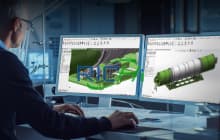
30 years of industry experience
Since its establishment in 1995, RICHI Machinery has amassed 30 years of rich experience in the design, production, and R & D of fish feed manufacturing plant. With our profound technical accumulation and global development, we can provide our customers with reliable equipment and solutions.
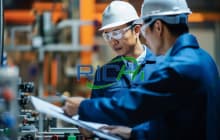
Customized turnkey solutions
We offer a complete turnkey production line, covering project design, equipment manufacturing, installation and commissioning, and personnel training, according to your specific needs. Whether it’s a small farm or a large feed factory, we can tailor a suitable production plan for you.

Complete after – sales service
We have a comprehensive after – sales system, providing you with all – round services from pre – sales consultation to after – sales maintenance. This includes professional and systematic training to help you quickly master equipment operation and maintenance skills and maximize project requirements.
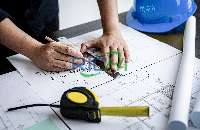
Built Around Your Needs
We can create customized turnkey pellet production line projects based on your unique requirements. For example, we provided customized technical solutions and operation training for the feed dryer machine to help the production line operate stably in the long term. You can find us on YouTube.


